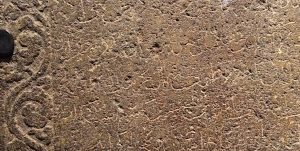
Galle (Sri Lanka). Stele of Zheng He (鄭和), detail of Persian portion. (Zenodo).
The inscription is engraved on a stone slab discovered in 1911 by H. F. Tomalin, the Provincial Engineer at Galle, in a culvert near the turn to Cripps Road within that town and afterwards moved to the Colombo Museum. The slab features inscriptions in three different languages, enclosed within a floral border: Tamil (top-left, IN03150), Persian (bottom-left) and Chinese (right, IN03152). The Persian inscription is dealt with here.
Following the discovery of the slab, the Chinese inscription was successfully transcribed and translated by Edmund Backhouse. However, Rao Bahadur H. Krishna Sastri (Assistant Superintendent for Epigraphy, Madras) and J. Horrovitz (Epigraphist for Moslem Inscriptions in India) failed in their efforts to decipher the Tamil and Persian texts respectively. Sometime later, the Tamil inscription was transcribed and translated for the third volume of Epigraphia Zeylanica (1933: 331–341) by Senarath Paranavitana, who benefitted from having access to Backhouse’s translation of the Chinese text. The Persian inscription is badly damaged but Khwaja Muhammad Ahmad of the Archaeological Department of H. E. H. the Nizam’s Dominions was able to compile a text and translation of the legible portion, which was published in 1933 as an appendix (Appendix B) to Paranavitana’s account of the Tamil inscription.
Following the discovery of the slab, the Chinese inscription was transcribed and translated by Edmund Backhouse. Like the Tamil inscription, it is dated in the second month of the seventh year of Yongle (永樂), the Chinese emperor whose reign began in 1403. The text features praise and offerings dedicated by the Chinese emperor, through his envoys Ching-Ho and Wang Ch’ing Lien, to the Buddha. The other two inscriptions on the slab feature similar lists of offerings but the beneficiary is different in each case, being a Hindu cult deity in the Tamil text and an Islamic saint or shrine in the Persian. It therefore appears that, when the Chinese arrived in Sri Lanka, they made gifts of equal value to several different religious traditions of the region and registered these gifts on the same stele.
[line 1] .. .. .. .. .. .. .. .. .. .. .. ..
[line 2] The great king .. .. .. .. .. .. by royal Order .. .. .. .. .. .. Ming .. .. .. ..
[line 3] .. .. .. .. .. .. .. .. .. .. .. .. .. has been sent to pay homage .. .. ..
[line 4] .. .. .. .. .. .. .. .. .. .. to seek help and .. .. .. .. .. .. ..
[line 5] .. .. .. .. .. .. .. .. .. ..
[line 6] .. .. .. .. .. .. .. .. .. .. it is known .. .. .. .. .. .. ..
[line 7] .. .. .. .. .. .. .. .. .. .. .. .. .. .. .. for .. .. .. ..
[line 8] and these miracles .. .. .. .. ..
[line 9] .. .. .. .. .. .. .. has been sent .. .. ..
[line 10] .. .. .. .. .. .. .. .. .. is known .. .. .. .. to pay his respects
[line 11] .. .. .. .. .. embroidered cloth, incense burners, flower-baskets .. .. and lamp oil
[line 12] .. .. .. .. .. for kind favour has sent these presents, so that
[line 13] .. .. .. .. Light of Islam
[line 14] .. .. the presents are as detailed below.
[line 15] Gold one thousand ‘Misqal.’ Silver five thousand ‘Misqal’ .. .. .. .. .. .. embroidered articles fifty in number
[line 16] .. .. .. .. .. fifty in number .. .. .. .. .. embroidered articles four .. .. .. .. .. altogether two pairs
[line 17] one pair yellow .. .. .. .. .. .. one pair .. .. incense burners of copper, five in number
[line 18] stand of copper, five in number .. .. .. .. .. .. .. five pairs .. red stands with gold work
[line 19] antique lamp stands five in number red stands worked in gold five in number—wooden with gold work five in number
[line 20] .. .. .. .. .. .. .. .. .. .. lamp oil .. .. .. .. .. .. ..
[line 21] .. .. .. .. .. .. date .. .. ..
[line 22] .. .. .. .. .. seventh year .. .. .. first of the month.